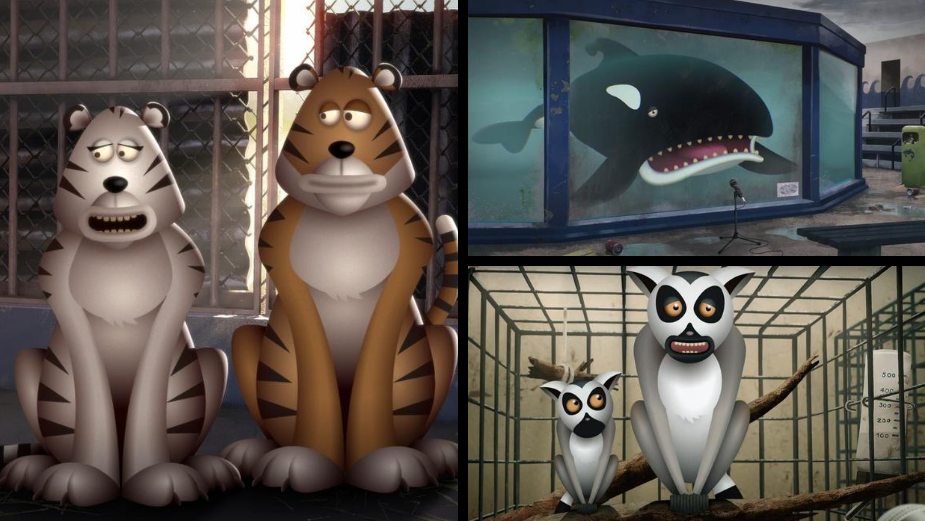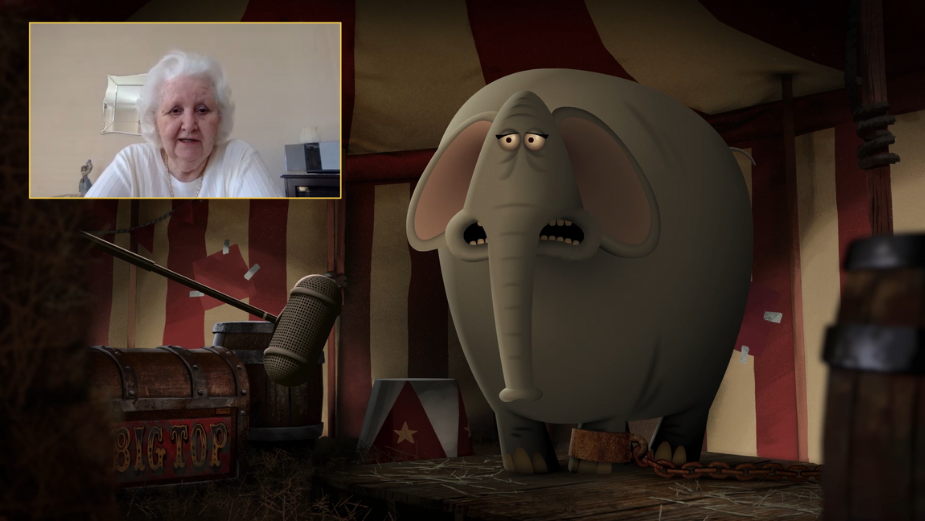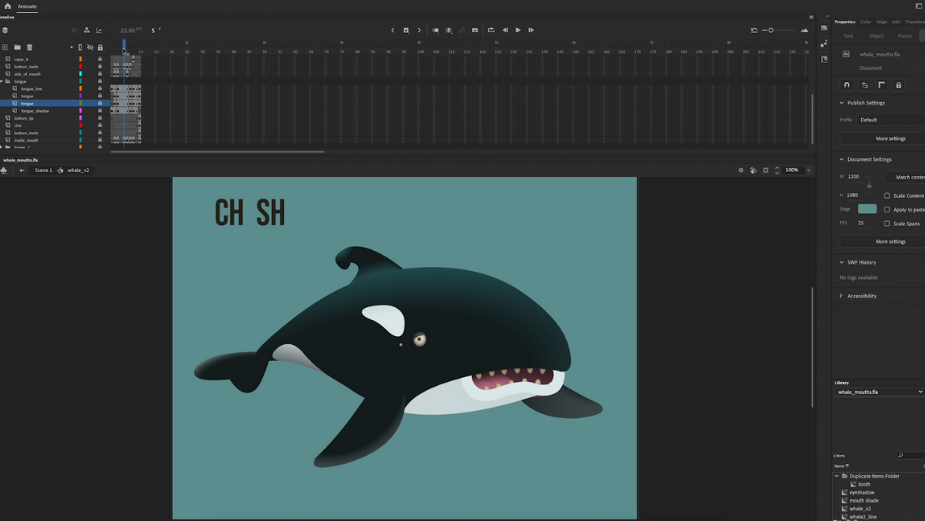
Creature Discomforts: How Lockdown Helped Us Realise the Plight of Animals in Captivity

Many a Brit will recognise and remember the much-loved claymation animals of the Creature Comforts series. The popular advertising campaign of the 90s and the ITV television series of the 2000’s was based on Nick Park’s Academy Award-winning short film of the same name. Right into the late-noughties, the comically relatable ads and tv series brought many a chuckle to British homes and still do. The comfortable vernacular of real-life conversations fronted by a cast of stop motion animals made us realise the humorously ironic links between us and the animal kingdom. However for 2020, Creature Comforts has taken on a new significance for the Born Free Foundation. Once light-hearted anecdotes from real homes, the new spot from creative agency Engine, uses real life recordings from people in lockdown to parallel the plight of animals in captivity.
The film, directed by Academy Award and BAFTA nominated director Peter Peake, uses interviews from people across the UK during the peak of lockdown. The participants were unaware of the true purpose of the project until after their interviews were finished in order to ensure honest and authentic answers. The result is a harsh reflection of conditions in which captive wild animals are forced to live.
The spot is the second in which this team (Born Free Foundation, Engine, Aardman and Jungle Studios) has worked on a project together. The first being the highly successful and totally heart wrenching short, ‘The Bitter Bond’ which was released in 2019.
For the latest work, the entire film was conceived and created under lockdown conditions, with all meetings, production and animation carried out remotely. Here we speak to Matt Smithers, Head of Marketing & Fundraising at Born Free, Steve Hawthorne, Creative Director at Engine, Ben Leeves, Sound Designer at Jungle Studios and Peter Peake, Director at Aardman to find out how they pulled this spot together...
Q > Born Free has been dedicated to animal conservation since 1984. Matt, what are the Foundation’s goals for 2020?
Matt Smithers, Born Free > Since 1984, Born Free has been dedicated to wild animal conservation and captive wild animal welfare. Our vision is to Keep Wildlife in the Wild. In a sense, today those ambitions remain as they were then. There are an estimated 10,000 zoos around the world, incarcerating millions of wild animals. Perhaps in this period of lockdown, many people have been able to better empathise with the plight of these captive wild animals for whom freedom remains but a dream. We have seen change: dolphinaria are in decline; many zoos are deciding not to keep species such as elephants and polar bears. Attitudes are changing, but the way we think about our relationship with nature remains key. From that change in thinking will flow the actions we need; increased investment in nature; a kinder, more compassionate approach to individual wild animals; the rejection of forms of wild animal exploitation such as circuses, roadside menageries and the keeping of wild animals as pets.
Q > Matt, the first campaign 'The Bitter Bond' was so powerful, how did it first come about?
Matt Smithers, Born Free > This was put forward as a brief to Engine following support and a public survey. Canned hunting is one of the most barbaric practices and our research showed that the public simply weren’t aware of it. Individuals going to these facilities to pet a lion cub had absolutely no idea about the fate of these animals. This was a massive opportunity to change the public’s behaviour.
Q > Ben, you worked on both campaigns, how were they different from a sound design and recording perspective?
Ben Leeves, Jungle Studios > These projects are totally different from a sound design perspective - not only because of the way we had to work in lockdown for Creature Discomforts but because of what they are. The Bitter Bond is a cinematic piece that had to lead us into a false sense of security that this was going to be a cute animated film about a young lion and flip us on our heads when he is brutally hunted in captivity. The easy calm sounds of a safe environment had to be starkly contrasted with an unexpected and deadly situation. For the second ad, we very much wanted to reflect real life conversations, so lots of sound design wasn’t necessary, the key to its success was capturing the voice overs cleanly.
Q > Matt, what insights incited this secondary campaign?
Matt Smithers, Born Free > We continue to work for a better world for wild animals, including those in captivity. During the pandemic, we all experienced first-hand what it was like to be locked up and have our freedom taken away... and we didn’t like it one bit. Yet, at the same time, we think it’s acceptable for wild animals to be caged for our education and entertainment. This campaign will hopefully move the public to empathise a little more with these animals in the future.
Q > Steve, what was the brief from Born Free for both campaigns and how did you approach them with the creative?
Steve Hawthorne, Engine > With Bitter Bond we had some new news, in that most people in the UK were simply unaware of the fact that the lions you can pet as cubs are often the same lions that get shot in canned hunting. And that by supporting the petting many tourists are unwittingly supporting the hunting. So what we needed was an engaging and powerful way to tell that story. With Creature Discomfort – Life in Lockdown the insight was that, due to lockdown, for the first time ever most humans could really empathise with how millions of captive wild animals feel. They didn’t have to imagine what it was like to be shut up inside against your will day after day. They were living it. So we needed a way to bring this comparison to life with a lightness of touch and while being mindful that lockdown has been very distressing for lots of people.
Q > Matt, what new challenges have arisen for animals in captivity as a result of the global pandemic?
Matt Smithers, Born Free > The collapse in international wildlife tourism means that funding for conservation has been badly hit. Wildlife law enforcement agencies are starved of income. Staff in lodges, eco-guards from conservancies and group ranches that support wildlife are being laid off in their hundreds of thousands. There is evidence that poachers are taking advantage of these weaknesses. In addition, the pressure on the public purse to support front line public health services, and support the incomes of people impacted by covid-19 are immense, leaving little in the kitty for conservation and environmental protection. We must develop more sustainable, inclusive and effective ways of supporting nature and at a much higher level. It is worth noting that in 2019, the UK invested over £90bn in its education system, over £40bn in defence, but just £3bn in protecting our environment. That immense imbalance means nature remains virtually defenceless and at the mercy of those who would exploit it with little thought or regard to the future. Only by valuing, investing in and securing the long-term future of the natural word, with the ecosystem services we all rely on, can we secure a future for all life on Earth – including ourselves. Covid-19 is not the fault of the animals – whether it originated from bats or pangolins or any other species. It is our fault for abusing nature in the way we have and creating the conditions for this pandemic. And it is our fault that we have, by and large, handled it so badly, failing to learn lessons from the past.
Q > The second campaign had to be created in the height of lockdown. What challenges did that pose?
Steve Hawthorne, Engine> Creating the ad in lockdown had a big implication for the animation style that we used. Using Aardman’s iconic Claymation technique wasn’t an option due to the time it takes and the fact that it requires multiple people to be in close physical proximity. So we needed a style that nodded to Creature Comforts while being created in 2D animation. The other big challenge was conducting the interviews. It’s tricky enough interviewing people who are not used to being interviewed at the best of times. But add to that the fact that these interviews were being conducted over Zoom (and some of our interviewees were in their 80s) and it has the potential to become even more awkward. Luckily Peter, our director, is very charming and was able to put people at ease very quickly. He conducted all of the interviews himself, one-to-one, to avoid our interviewees feeling overwhelmed by having a screenful of strangers staring at them during the interview.
Q > Peter, were there challenges in directing the actors remotely?
Peter Peake, Aardman > There were no actors involved! In keeping with the Creature Comforts tradition we conducted interviews with the general public and used their responses which were spontaneous and unscripted. All the voices came from friends and family that the agency and myself approached to take part. I interviewed a shortlist of about 16 willing volunteers remotely over zoom and was genuinely overwhelmed by how many great quotes and poignant insights they came up with. The fact that our interviewees were talking about such a huge topic as lockdown, that has affected us all, definitely gave them a lot to reflect on and discuss. They're all talking about their real, current situations and their personal feelings about them. The hardest part of making this film was knowing we couldn't use it all and had to be brutal in whittling it down to our final choices.

Q > Steve, how did you have to adapt to working with Aardman & Jungle as a result?
Steve Hawthorne, Engine > We had a LOT of Zoom calls. Luckily the team involved was small and nimble and we all worked very tightly together. We didn’t have multiple layers of people to go through to make decisions. The fact that Aardman and Jungle are both experts at the top of their fields helped greatly as they have seen it, done it, got the t-shirt. We could put absolute trust in them and didn’t need to go through rounds and rounds of revisions.
Q > Peter, how did you work with the team at Jungle to capture clean recordings of all the actors' VOs?
Peter Peake, Aardman > Jungle very kindly provided our interviewees with a guide to creating a basic home recording set up which largely involved them talking into their wardrobes! (the clothes inside the wardrobes provided excellent conditions to deaden the sound). Given that most of my interviewees were talking to me on their laptops I found myself in the unusual position of interviewing them from inside their bedroom wardrobes on more than one occasion. Quite an odd experience. Jungle also provided easy to follow instructions on how to best record yourself on your phone and even though the interviews were carried out over zoom the interviewees simultaneously recorded themselves this way too. The additional phone recordings were used for the final audio and I'm staggered by how good the quality was thanks to Jungle's expert guidance.

Q > Ben, in terms of Sound Design, what was the biggest challenge once you had the recordings?
Ben Leeves, Jungle Studios > For us, the biggest challenge should be inaudible to the human ear. Whilst our participants were feeling the effects of lockdown, their home environments were much different to those of animals in cages. We had to ensure the remote recordings weren’t taken in an echoey living room or kitchen as the illusion of the film would be ruined completely. However, making the sound authentic and creating a suitable environment sound is definitely the trickiest part ! Luckily the participants were great at following our remote recording instructions and Peter was fantastic at creating a comfortable environment for them to speak - even from their wardrobes!
Q > Were the choices of animals in the film correlating to those species who need the most help to return from captivity?
Steve Hawthorne, Engine > The animals were chosen primarily based on the voices of the interviewees that we ended up featuring in the ad. In some cases we picked an animal because it matched the voice and in other cases we picked an animal precisely because it didn’t. Then on top of that we were looking to pick animals that are at risk and relevant to Born Free’s work, with a spread from animals that end up in zoos, circuses, aquariums and as pets.
Q > Peter, how long did it take to develop all the animated characters and how did you choose which animals to represent?
Peter Peake, Aardman > It took just under three weeks to take the characters from initial sketches to the fully coloured and shaded versions you see in the final film. With the choice of animals we wanted to feature those that were particularly susceptible to bad treatment in captivity and Born Free were invaluable in guiding us in this and informing us which species were especially at the forefront of their campaigning.

Q > What are your goals for this campaign? The first ad created a lot of buzz. How do you want to build on that?
Steve Hawthorne, Engine > We would love this campaign to get people stop and think about how they view captive animals. Ideally with a bit more empathy. On top of that we would love to raise awareness of Born Free and the great work that they do around the world to Keep wildlife in the wild. And, if people are able to, it would be great if they could donate a few pounds to help Born Free keep up that great work.
Q > Why is animation a great medium to tap into people's emotions and really move them towards a cause?
Peter Peake, Aardman > In this particular instance I hope the animation initially draws you in with characters that people find charming and endearing. The use of real people's voices talking about a very real and shared experience then hopefully adds a relatable element. I think this approach avoids being too preachy or overbearing and allows people to make their own connections which can often be a powerful thing.













